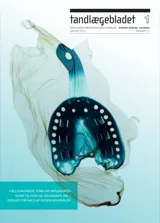Röntgenundersökningen inför implantatbaserad protetisk rehabilitering
Sedan metoden att utnyttja osseointegrerade implantat i samband med rehabiliteringen av den tandlösa patienten introducerades, har indikationsområdet vidgats och allt fler och allt yngre personer kommit att behandlas. Detta ställer särskilda krav på att röntgenundersökningarna görs så att stråldosen blir så liten som möjligt, utan att den för planeringen och behandlingen nödvändiga informationen riskerar att förloras. En noggrann klinisk undersökning bildar underlaget för vilken information röntgenundersökningen måste bidraga med. Det är inte bara den självklara informationen om tillståndet i det tänkta implantatområdet utan också om förhållandena i ett eventuellt restbett. I dag finns det flera röntgentekniker som kan användas för att beskriva de förhållanden som avgör om implantatbehandling är lämplig och, om så är fallet, möjliga implantatsätens tillstånd och deras förhållande till omgivande anatomiska strukturer. Det senare är viktigt för att minimera risken för allvarliga komplikationer. I artikeln beskrivs de vanligaste röntgenteknikerna och hur de kan användas. Den som skriver en remiss för röntgenundersökningen måste vara noga med att klargöra vilka frågor hon/han vill ha svar på. Då kan radiologen välja den teknik som mest kostnadseffektivt leder till att den nödvändiga informationen kan erhållas med lägsta möjliga dos.
Imaging and implant treatment: from radiographical pretreatment assessment and follow-up to virtual treatment planning Since the technique to use osseointegrated implants in the rehabilitation of the edentulous patient was introduced, the indications for this type of technology has been widened and more and younger persons are now being treated. This sharpens the demands that the x-ray examinations are performed so that the radiation dose becomes as small as possible without jeopardizing the information that is needed for appropriate treatment planning. A thorough clinical examination provides the basis for a subsequent x-ray examination in that it defines the information that the latter should contribute with. It is not only information about the implant site but also about the conditions of the remaining teeth. Today there are many radiographic techniques that can be used to describe the conditions needed to establish whether implant treatment is the treatment of choice and, if so, the condition in the implant site/s and their relation to neighbouring anatomic structures. The latter is important to minimize the risk for se rious complications. In the article we describe the most common radiographic techniques and how they can be used. The dentist who refers a patient for an x-ray examination must care- fully determine what questions s/he wants to have answers to. Then the radiologist can best choose that radiographic technique that most cost-effectively can provide the necessary information with the lowest possible dose.


